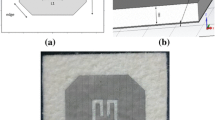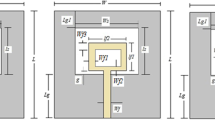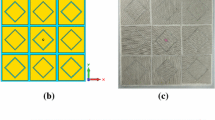Abstract
In this article, an ultra-wideband, dual-port, textile antenna on jeans substrate has been designed and simulated for wearable and MIMO applications. The antenna consists of a partial ground plane on which a square shape has been cut out from the corner. It gives very wide bandwidth ranging from 1.58 GHz to 10.08 GHz and achieves isolation at least −11 dB throughout the operating band. The design has been done on 1.8 mm jeans substrate having dielectric constant 1.67. When ports are excited individually for both the polarizations, the gain of 2.73 dBi, 3.52 dBi, and 5.27 dBi is obtained at 3.5 GHz, 6 GHz, and 10 GHz, respectively. In addition to isolation between the ports, envelope correlation coefficient (ECC) and diversity gain have been calculated. The antenna is made out of a textile material, and as a result, it has a high level of structural flexibility and manufacturing precision. Using the Finite Integral Technique (FIT) numerical method, the provided two-port antenna structure is examined, investigated, and optimized.
Access provided by Autonomous University of Puebla. Download conference paper PDF
Similar content being viewed by others
Keywords
1 Introduction
An important part of any wireless communication is the antenna, which is available in variety of shapes and sizes. Some of them are microstrip patch antenna, slot antenna, horn antenna, Vivaldi antenna, etc. Planar shape patch antenna is very much compatiple and suitable in wearable devices applications (Sanjaria et al. 2013). Microstrip patch antenna has been an area of interest for both the academia and industries for over more than seven decades. In recent years, the application of microstrip patch antenna in the Personal Area Network (PAN), or more specifically, the Wireless Body Area Network (WBAN), has received a lot of attention. Apart from this, microstrip patch antenna is highly useful in wearable biosensors, cameras, computers, healthcare, military, and a range of other wearable technologies. Such advancements arouse our interest in the creation and evolution of wearable antennas that are embedded in our clothing (Sundarsingh et al. 2014). Textile antennas are latest research interest because of its easy fabrication and good integration with planar circuits. These antennas are flexible, robust, highly efficient and possess low specific absorption ratio (SAR) (Mao et al. 2020). It is hugely desirable to have a transmitting and receiving antenna in a single antenna system for the most effective use of duplexing systems (Mao et al. 2020). In order to develop such antenna system, multiple-input multiple-output (MIMO) is used at both transmitter and receiver sides. MIMO antennas are better than single-input single-output (SISO) antennas in terms of channel capacity and transmitted power (Jensen and Wallace 2004; Choi et al. 2014). Channel capacity is directly proportional to the bandwidth of the system and it is improved with the use of ultra-wideband (UWB) antennas (Siddiqui et al. 2019). MIMO antennas sometimes use polarization diversity to double the channel capacity. Since these antennas use one radiating element and two ports, the isolation between the ports is very important to study. Multiple attempts have been made to design such antennas focusing bandwidth enhancement (Mao et al. 2020; Saxena et al. 2020), isolation improvement (Moradikordalivand et al. 2014; Chung and Yoon 2007; Luo et al. 2015), and gain improvement (Saxena et al. 2020). It has been reported that coupling degrades due to increased signal correlation between multiple radio signals (Singh et al. 2021). Numerous structures such as parasitic ring element (Moradikordalivand et al. 2014), extra ground wall (Chung and Yoon 2007), and approach for neutralization techniques on the ground plane (Luo et al. 2015) have been used between the ports to improve the isolation further.
In this paper, a dual-polarized, ultra-wideband, low profile, wearable, MIMO antenna has been designed and simulated in CST v.19. It has been designed on a general jeans substrate of dielectric constant 1.67 and height 1.8. Parameters like ECC and diversity gain have also been calculated to study isolation between the ports. The outline of the paper is as follows, Sect. 2 deals with antenna design, Sect. 3 includes results and discussion, and the last section summarizes the conclusion.
2 Antenna Design
2.1 Configuration
The design consists of a patch antenna on a jeans substrate of height 1.8 mm and dielectric constant 1.67 having one edge cut in the fashion of stairs. It has been feed from two orthogonal sides to have dual polarization in both the orthogonal planes. A partial ground has been used on the other side. The designed antenna has been shown in Fig. 1a with all the dimensions marked. Figure 1a shows the top view of the design which is very compact and uses no extra circuit for bandwidth enhancement. Figure 1b, on the other hand, shows the ground plane. Through a 6 mm long, 6.5 mm (50 Ω) broad microstrip line, the square shape patch is fed. The square patch has 58 mm side length. A square shape of sides 17.5 mm has been cut out from ground plane in order to enhance the bandwidth and improve the isolation between the ports. The antenna design and optimization are performed using the CST—Computer Simulation Technology based upon Finite Integration in Technique (FIT)
3 Results and Discussion
Ultra-wide bandwidth (UWB) of 145.8% ranging from 1.58 to 10.08 GHz has been obtained. Return losses (S11 and S22) are well below −10 dB, and also, the coupling coefficients (S12 and S21) are less than −11 dB throughout the bandwidth. The design possesses good isolation in lower and upper bands which is less than -15 dB in frequencies ranging from 1.7 to 2.7 GHz and 6.4 to 10 GHz. Since the design is physically symmetrical, the value of S11 with S22 and S21 with S12 is almost identical. The parameter ‘Sc’ (square cut) has been optimized and simulated for 17, 17.5, 18, and 19 mm and the return loss less than 10 dB and isolation less than 11 dB come at 17.5 mm as shown in Fi 3.
The radiation efficiency of the proposed antenna is shown in this Fig. 4a. The proposed antenna has an average radiation efficiency of 65%. The gain of the proposed antenna is shown in Fig. 4b. The proposed antenna has an average peak gain of 5.2dBi. Simulated gain for this antenna varies from 0.08 to 5.2 dBi as shown in Fig. 4b. Surface current is measured and plotted at 3.5 GHz as shown in Fig. 5.
ECC is a measure of isolation between the ports in a multiport MIMO antenna. It is desirable to have ECC as minimum as possible to minimize the isolation between the ports (Singh et al. 2021). ECC is calculated either using far-field pattern or using s-parameters of the system as given in Eq. 1 (Saxena et al. 2020). It is less than 0.02 throughout the band of operation.
Another term is diversity gain which conveys same information about the isolation of the ports and it is related to ECC as given in Eq. 2 (Saxena et al. 2020). Diversity gain is 9.95 or above throughout the band of operation for this design (Fig. 6).
The proposed design has physical size of 58 × 58 mm2 which is smaller as compared to (Sundarsingh et al. 2014; Moradikordalivand et al. 2014; Rais et al. 2013). The design has 1.58–10.08 GHz and 145.8% of fractional bandwidth which is better as compared to (Sundarsingh et al. 2014; Mao et al. 2020; Ononchimeg et al. 2010; Rais et al. 2013) as shown in (Table 1).
4 Conclusion
A compact, dual-port, dual-polarized, ultra-wideband antenna for full-duplexing wearable application has been designed and simulated. The design consists of a stair cut patch antenna placed on jeans substrate backed by a partial ground with a square cut on the edge. The simulation result shows good reflection coefficients, isolation between the ports, and radiation characteristics throughout the band. Designed antenna is suitable for wearable and/or full-duplex applications such as health care, defense, and IoT. Isolation 15 dB has been achieved in the frequency range 1.7–2.7 GHz and 6.4–10 GHz. The efficiency of up to 65% is obtained in the required frequency band. Diversity gain of approximately 9.95 dB and envelope correlation coefficient below 0.02 have been obtained for diversity applications.
References
Choi DY, Shrestha S, Park JJ, Noh SK (2014) Design and performance of an efficient rectenna incorporating a fractal structure. Int J Commun Syst 27(4):661–679
Chung K, Yoon JH (2007) Integrated MIMO antenna with high isolation characteristic. Electron Lett 43(4):199–201
Fallahzadeh S, Bahrami H, Akbarzadeh A, Tayarani M (2010) High-isolation dual-frequency operation patch antenna using spiral defected microstrip structure. IEEE Antennas Wirel Propag Lett 9
Hussein AH, Abdullah HH, Attia MA, Abada AM (2019) S-band compact microstrip full-Duplex Tx/Rx patch antenna with high isolation. IEEE Antennas Wirel Propag Lett 18(10)
Jensen MA, Wallace JW (2004) A review of antennas and propagation for MIMO wireless communications. IEEE Trans Antennas Propag 52(11):2810–2824
Luo CM, Hong JS, Zhong LL (2015) Isolation enhancement of a very compact UWB-MIMO slot antenna with two defected ground structures. IEEE Antennas Wirel Propag Lett 14:1766–1769
Mao CX, Zhou Y, Wu Y, Soewardiman H, Werner DH, Jur JS (2020) Low-profile strip-loaded textile antenna with enhanced bandwidth and isolation for full-duplex wearable applications. IEEE Trans Antennas Propag 68(9)
Moradikordalivand A, Rahman TA, Leow CY, Ebrahimi S (2014) Dual-polarized MIMO antenna system for WiFi and LTE wireless access point applications. Int J Commun Syst
Ononchimeg S, Bang J-H, Ahn B-C (2010) A new dual-polarized gap-fed patch antenna. Progr Electromagn Res C 14:79–87
Rais NHM, Soh PJ, Malek MFA, Vandenbosch GAE (2013) Dual-band suspended-plate wearable textile antenna. IEEE Antennas Wirel Propag Lett 12:583–586
Sanjaria HR, Meratib AA, Varkiania SMH, Avakoli A (2013) A study on the effect of compressive strain on the resonance frequency of rectangular textile patch antenna: elastic and isotropic model. J Tex Inst 105(2):156–162
Saxena G, Jain P, Awasthi YK (2020) High diversity gain MIMO-antenna for UWB application with WLAN notch band characteristic including human interface devices. Wirel Pers Commun
Siddiqui JY, Antar YMM, Saha C (2019) Multifunctional ultrawideband antennas trends, techniques and applications. Taylor & Francis Group
Singh AK, Mahto SK, Sinha R (2021) Compact super-wideband MIMO antenna with improved isolation for wireless communications. Frequenz 75:407–417
Sundarsingh EF, Velan S, Kanagasabai M, Sarma AK, Raviteja C, Alsath MGN (2014) Polygon-shaped slotted dual-band antenna for wearable applications. IEEE Antennas Wirel Propag 13:611–614
Upadhyay G, Tripathi VS (2017) Pin-diode based switchable multiband dual feed microstrip patch antenna. Microw Opt Technol Lett 59(6).
Author information
Authors and Affiliations
Corresponding author
Editor information
Editors and Affiliations
Rights and permissions
Copyright information
© 2024 The Author(s), under exclusive license to Springer Nature Singapore Pte Ltd.
About this paper
Cite this paper
Dalakoti, N., Jain, P. (2024). Dual-Polarized Textile Antenna for Full-Duplex Wearable Applications. In: Mehta, G., Wickramasinghe, N., Kakkar, D. (eds) Innovations in VLSI, Signal Processing and Computational Technologies. WREC 2023. Lecture Notes in Electrical Engineering, vol 1095. Springer, Singapore. https://doi.org/10.1007/978-981-99-7077-3_30
Download citation
DOI: https://doi.org/10.1007/978-981-99-7077-3_30
Published:
Publisher Name: Springer, Singapore
Print ISBN: 978-981-99-7076-6
Online ISBN: 978-981-99-7077-3
eBook Packages: EngineeringEngineering (R0)










